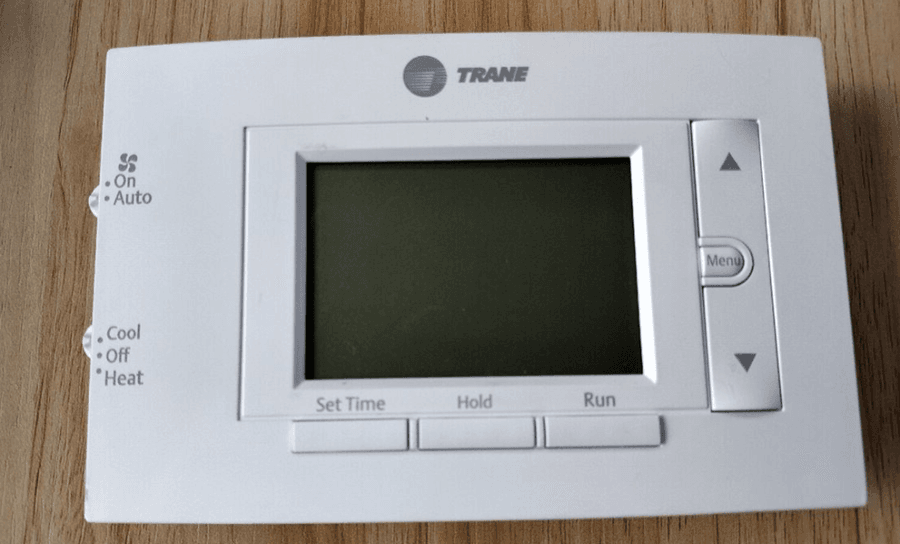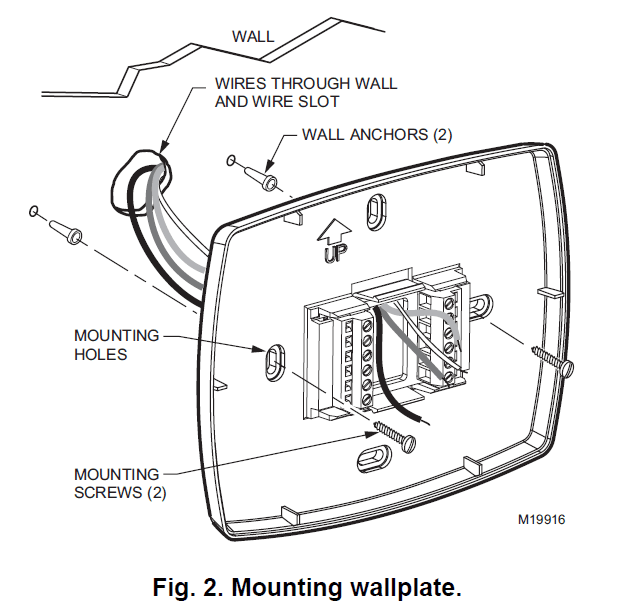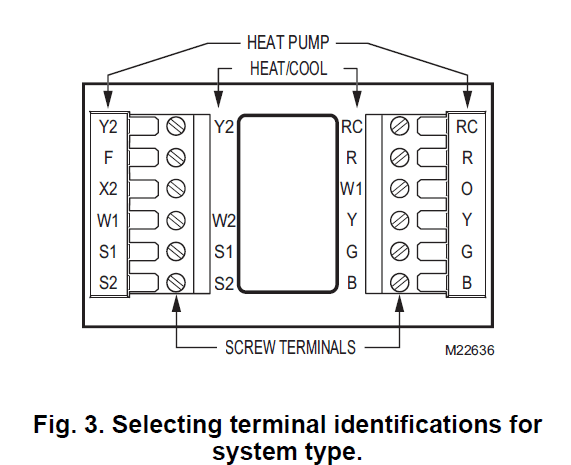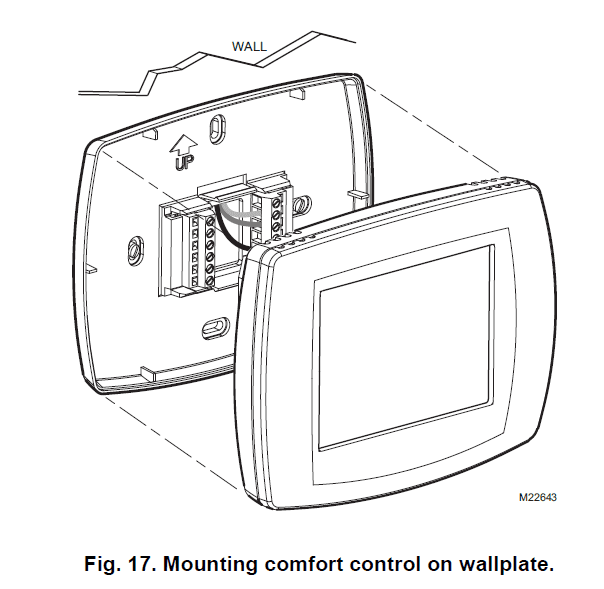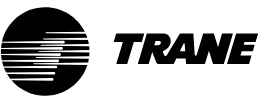
Trane TCONT803AS32DA Multi-Stage Thermostat

APPLICATION
The TCONT802AS32DA and TCONT803AS32DA Touch Screen Comfort Controls provide electronic control of 24 Vac heating and cooling systems. See Table 1 for a general description.
| Power Method | Changeover | System Selection | Fan Selection | Comments |
| 24 Vac common wire | Automatic or manual selectable | Heat-Off-Cool- Auto (Em. Heat for heat pumps) | On-Auto-Circ | System and Fan selection vary based on system type |
| System and Fan selection vary based on System type. Humidity sensor to control dehumidification. |
Table 1. TCONT802AS32DA and TCONT803AS32DA Comfort Control Description.
INSTALLATION
When Installing this Product…
Selecting Location
Install the comfort control about 5 ft. (1.5m) above the floor in an area with good air circulation at average temperature. See Fig. 1.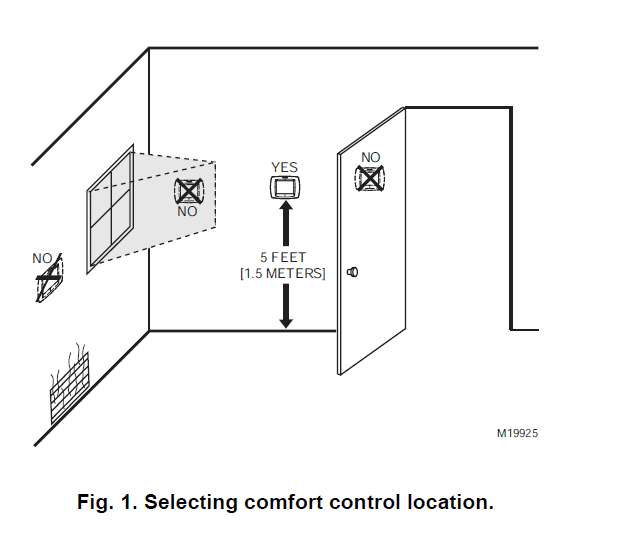
- Read these instructions carefully. Failure to follow the instructions can damage the product or cause a hazardous condition.
- The installer must be a trained, experienced service technician.
- After completing installation, use these instructions to check out the product operation.
Do not install the comfort control where it can be affected by:
- Drafts or dead spots behind doors and in corners.
- Hot or cold air from ducts.
- Radiant heat from sun or appliances.
- Concealed pipes and chimneys.
- Unheated (uncooled) areas such as an outside wall behind the comfort control.
Installing Wallplate
The comfort control can be mounted horizontally on the wall or on a 4 in. x 2 in. (101.6 mm x 50.8 mm) wiring box.
- Position and level the wallplate (for appearance only).
- Use a pencil to mark the mounting holes.

- Remove the wallplate from the wall and, if drywall, drill two 3/16-in. holes in the wall, as marked. For firmer material such as plaster, drill two 7/32-in. holes. Gently tap anchors (provided) into the drilled holes until flush with the wall.
- Position the wallplate over the holes, pulling wires through the wiring opening. See Fig. 2.
- Insert mounting screws into the holes and tighten.
WIRING (FIG. 5-15)
All wiring must comply with local electrical codes and ordinances.
- Select a set of terminal identifications (Table 2) that corresponds with the system type (heat/cool or heat pump in Fig. 3).
- Loosen the screws for the appropriate system type selected; see Table 2. Insert wires in the terminal block under the loosened screw. See Fig. 4.
- Securely tighten each screw.
- Push excess wire back into the hole.
- Plug the hole with nonflammable insulation to prevent drafts from affecting the comfort control.

Table 2. Selecting Terminal Identifications for System Type.
|
System Type | Wallplate Terminal Identifications | Wiring Diagram Reference |
| Standard Heat/Cool | Heat/Cool | Fig. , Fig. |
| Standard Multistage up to 2 Heat/2 Cool | Heat/Cool | Fig. 7, Fig. 8 |
| Heat ump with Electric Auxiliary (Backup) Heat | Heat ump | Fig. , Fig. 10, Fig. 11 |
| Heat ump with Fossil Fuel Auxiliary (Dual Fuel) Heat | Heat pump | Fig. 12, Fig. 13, Fig. 14, Fig. 1 |
NOTE: The factory default setting is configured for a 1 Heat/1 Cool System with a gas furnace.
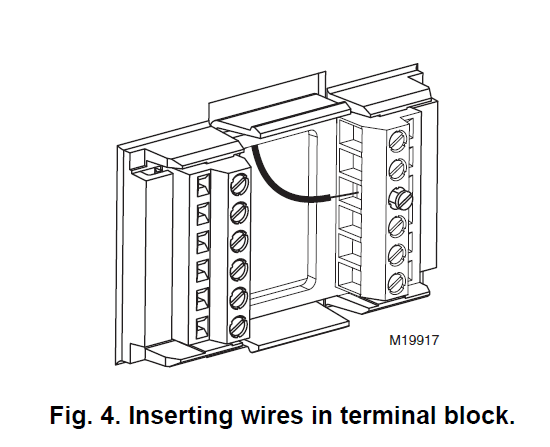
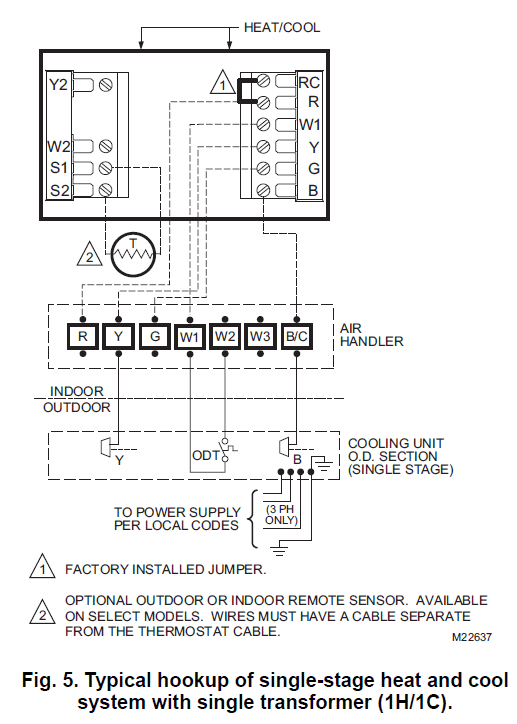

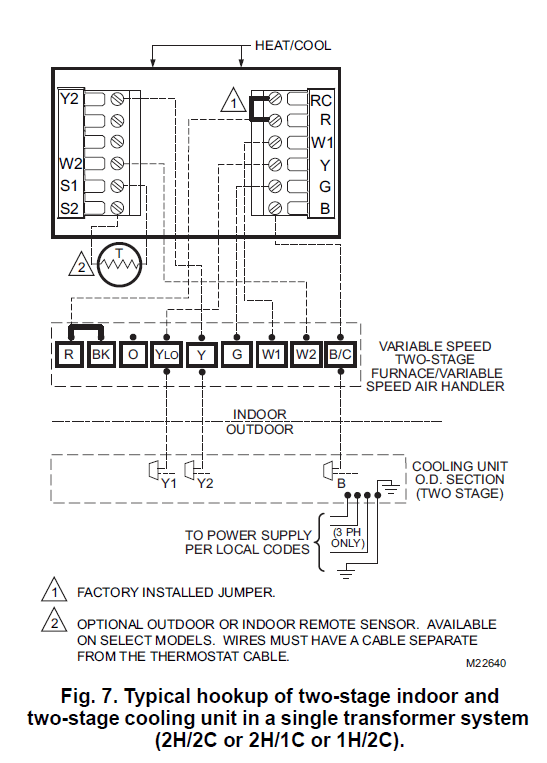
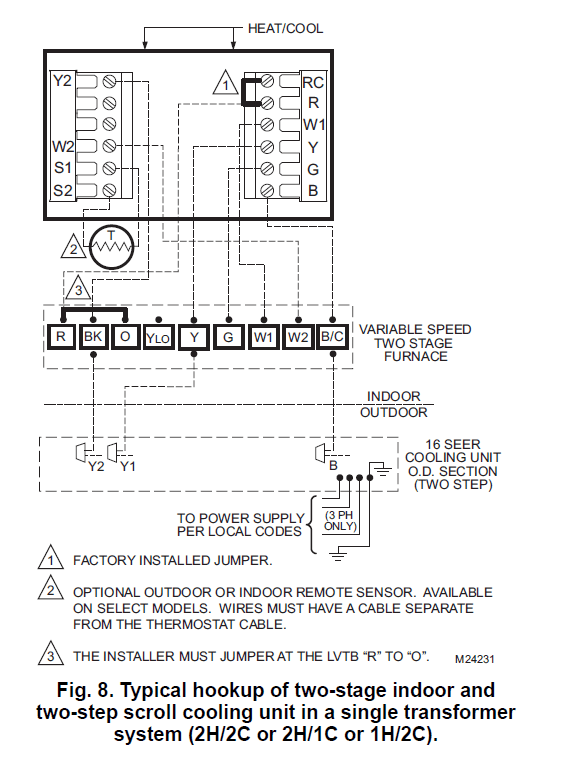

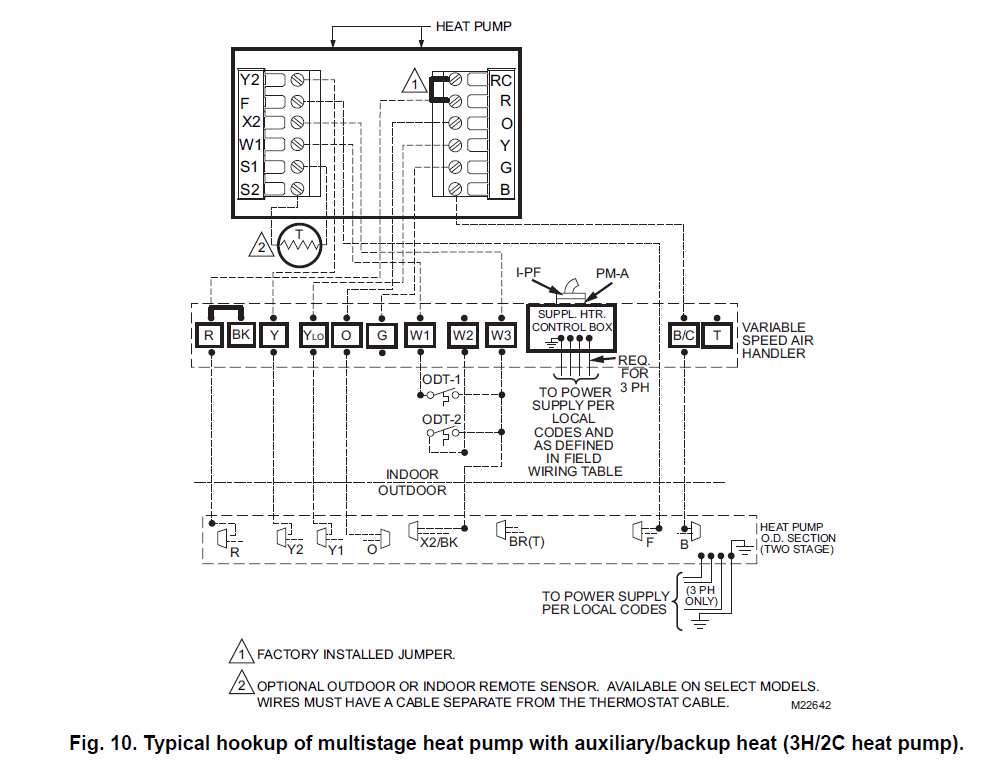
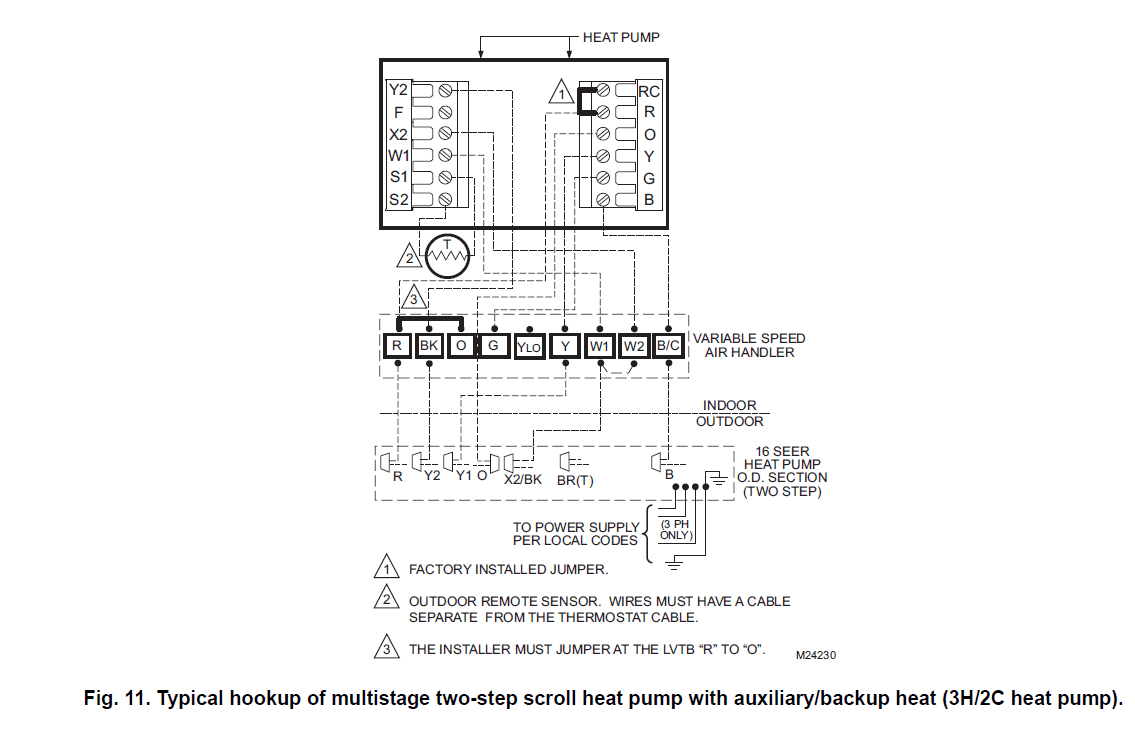
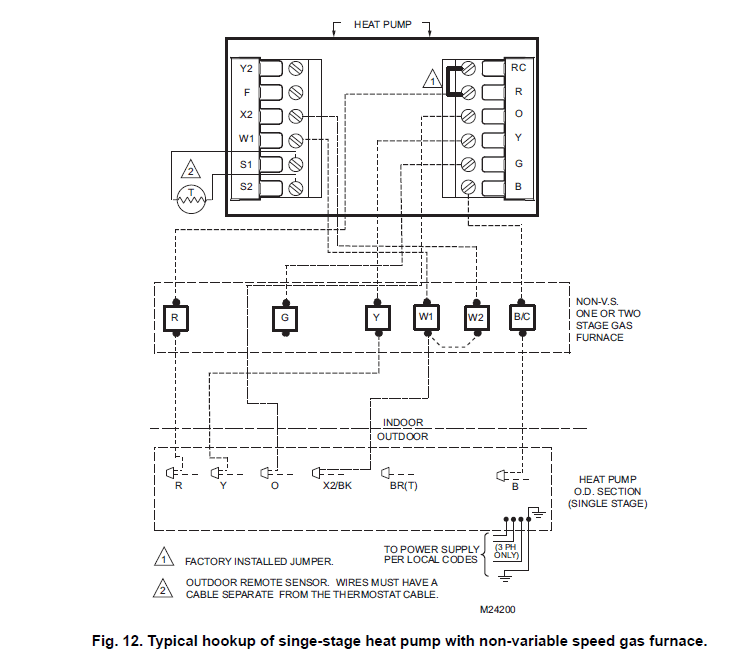
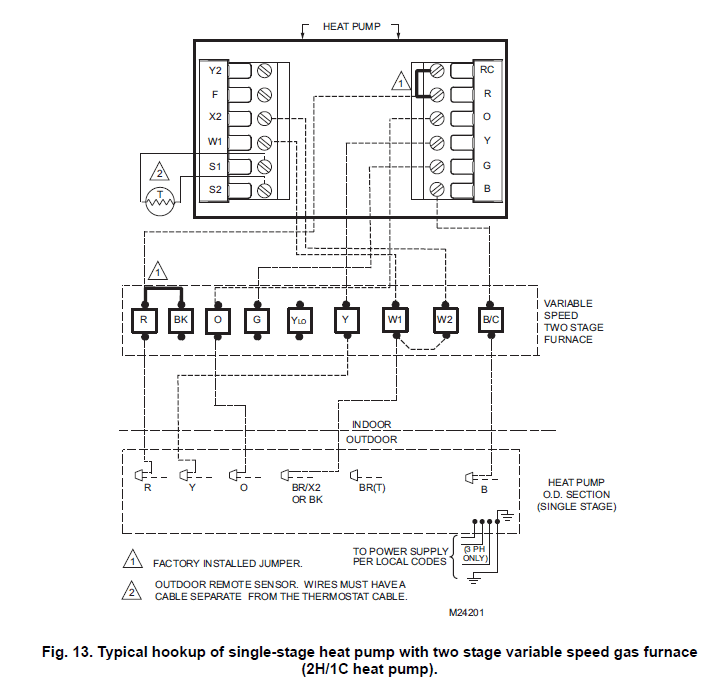

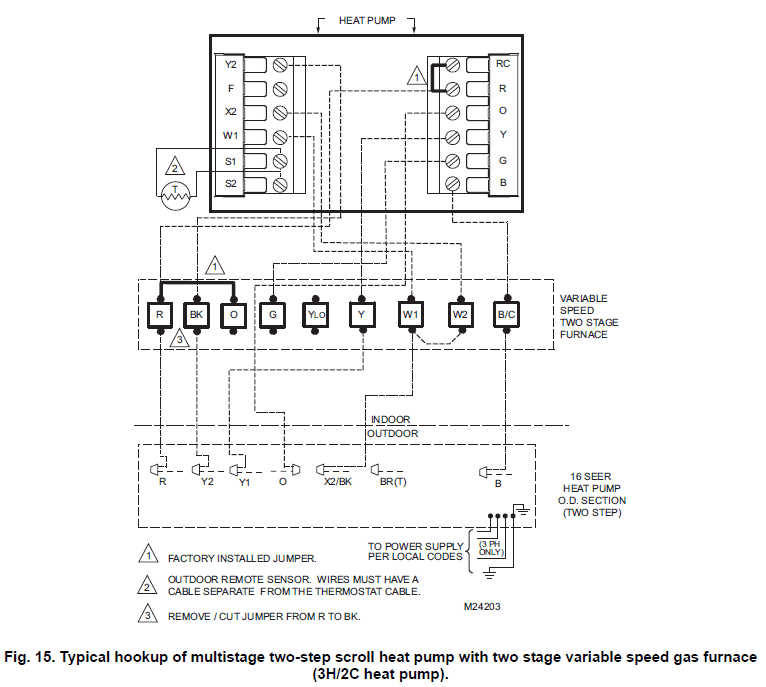
Powering the Comfort Control
The Comfort Control can be powered with 24 Vac. 24 Vac Common Power (Recommended) Wire the common side of the transformer to the B screw of the comfort control wallplate. When installing in a single transformer system, keep the jumper wire between the R and Rc screws. When installing in a two-transformer system, use the common from the cooling transformer to connect to the B screw and remove the jumper wire between the R and Rc screws.
Battery Power (Optional)
Three AAA alkaline batteries can be used to power the comfort control for armchair programming only. To prevent the comfort control and heating/cooling system from shutting down due to lack of battery power, it is not recommended that the comfort control be solely powered with the three AAA batteries during normal system operation. When using batteries, make sure positive and negative terminals are oriented correctly, as marked on the device. See Fig. 16.
Mounting the Comfort Control
- Align the terminal screw blocks with the pins on the back of the comfort control.
- Push the comfort control straight onto the wall plate. See Fig. 17.

Adjusting Real-Time Clock
Setting Calendar and Time
Locate and remove the tab labeled Remove in the lower left corner on the comfort control back. The tab must be removed to activate the real-time clock. See Fig. 18.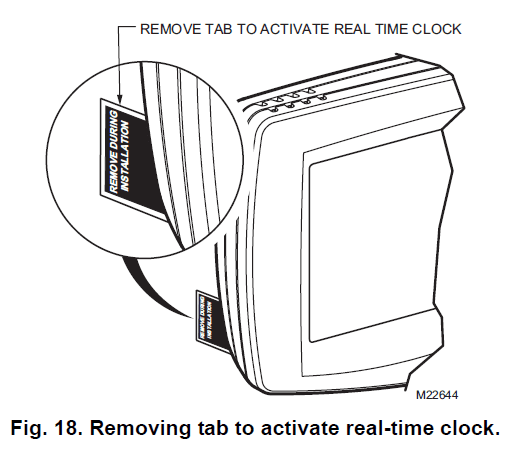
This comfort control is designed to automatically keep the current time and day in memory for up to ten years under normal use once the calendar is set. When the comfort control is first powered, the display is ready for the calendar date to be entered. See Fig. 19.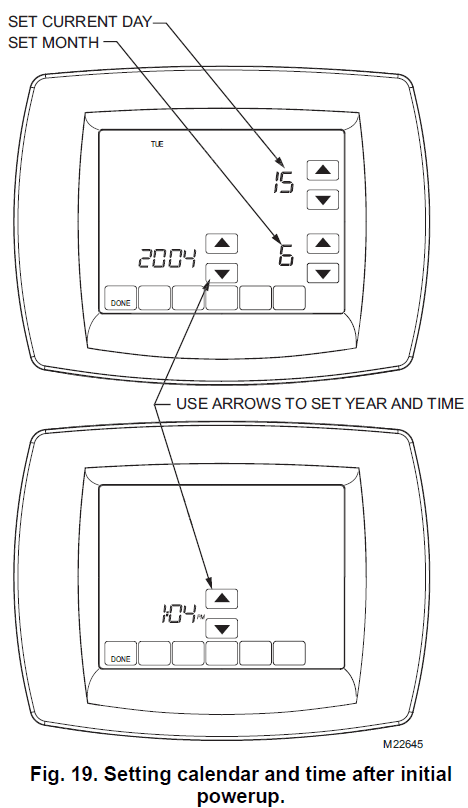
IMPORTANT: The tab on the back of the comfort control in the lower left corner must be removed for this feature to be active.
Using the Comfort Control
The comfort control has a touchscreen interface. Words or symbols appear, highlighting the keys, as necessary, to complete tasks. Always press the keys with your fingertips. Sharp instruments like a pen or pencil point can damage the comfort control.
- Use the arrow keys to set the Year, Month, and Day, as shown in Fig. 19.
- Press the Done key.
- Use the arrow keys to set the current time. See Fig. 19.
- Press the Done key.
OPERATION
System and Fan Settings
The System’s default setting is Heat and the Fan default setting is Auto.
SYSTEM SETTINGS
- Heat: controls heating system.
- Off: The heating and cooling are off.
- Cool: controls cooling system.
- Auto: automatically changes between heating and cooling systems, depending on indoor temperature. (See Installer Setup section.)
- Em Heat: emergency heat cycles to maintain temperature. The compressor is locked out. (Used only for heat pump systems with backup heat.)
FAN SETTINGS
The Fan setting can be programmed into the comfort control schedule for each period (Wake, Leave, Return, Sleep). See the Owners’ Guide for additional information.
LED Indication (Requires 24 Vac Common Connection)
An LED indicator is located in the upper right corner of the comfort control. It is only visible when lighted:
- It indicates when the comfort control is in the Emergency Heat mode. When in Em. Ht. mode, the
F terminal is continuously energized and the LED is on. - When the F terminal is wired to an equipment monitor, the LED signals when a check or fail signal is sent to the comfort control from the system. See Fig. 20. (This can occur only when the comfort control is not in Em. Ht. mode.)

Preprogrammed Settings
Table 3 shows the default program settings. See Owner’s Guide for complete instructions on changing the program.
Table 3. Default Program Settings.
| Schedule Period | Time | Setpoints | Fan Setting | |
| eat | Cool | |||
| Wake | 6: 00 AM | 70°F (21°C) | 78°F (25.5 °C) | Auto |
| Leave | 8:00 AM | 62°F (16. 5°C) | 85°F (29.9 °C) | Auto |
| return | :00 M | 70°F (21°C) | 78°F (25.5 °C) | Auto |
| Sleep | 10:00 M | 62°F (16 .5 °C) | 82°F (28°C) | Auto |
INSTALLER SETUP
The comfort control works with many different system types. To operate correctly, the comfort control must be set up to operate the installed heating and/or cooling system.
Follow these steps to enter the Installer Setup:
- Be sure the comfort control is powered.
- Press and release the System Key.
- Press and hold the two blank keys on either side of the center blank key for approximately five seconds until the screen changes.
- Release the two blank keys when the screen on the comfort control matches the screen below.
- See the screen below to review how the comfort control keys are used during Installer Setup. See Table 4 for the Installer Setup Numbers and Settings.
- Press the Done key to exit the Installer Setup screen.
IMPORTANT: The Installer Setup Menu (Table 4) shows all the available options. These options customize themselves as you make selections for the Installer Setup. Therefore, not all Installer Setup Selections are shown or are available to change.
Table 4. Installer Setup Menu.
|
Select |
Installer Setup Number | Factory Setting | Other Choices |
Comments | ||
|
Option |
Description |
Options |
Description | |||
| Not used. | 1 thru 00 | – | – | – | – | – |
| Date (Year pper) | 0120 | 20 | Set first two digits of current calendar year (20 for year 200 , etc) | 21 | 21 -first two digits of current calendar year (21xx) | 2000 – 2178 available |
| Date (Year Lower) | 0130 | 0 | epresents last two digits of current calendar year (2005). | 00 – | Select last two digits of current calendar year. | 2000 – 2178 available |
| Date (Month) | 0140 | Digit(s) represents current calendar month. | 1-12 | Select number that represents current calendar month. | – | |
| Date (Day) | 01 0 | 1 | Digit(s) represents current calendar date. | 1-31 | Select number that represents current calendar date. | – |
| Schedule Options | 01 0 | 4 | 7-day programming | 0 | 0-nonprogrammable | – |
| System Type Selection | 0170 | 1 | 1 Heat/1Cool | 1-12 | 1-1heat/1cool 2- single-stage heat pump (no aux. heat) 3- heat only (no fan) 4- heat only (with fan) 5- hot water Series 20 (3-wire or normally open zone valves) 6-cool only 7-2 heat/1cool heat pump 8-2 heat/2 cool 9-2 heat/1cool 10-1 heat/2 cool oil furnace or 0H/2C 11-2 heat/2 cool heat pump (with no auxiliary heat) 12-3 heat/2 cool heat pump (with auxiliary heat) | Available options and defaults vary by comfort control. System selection automatically modifies some default settings and/ or hides other Installer Setup options. |
| Fan Operation | 0180 | 0 | Heat/Cool applications where equipment controls fan operation in heat mode. | 1 | Heat pump or electric heat applications where comfort control controls fan operation in heat mode. | Only shown if heat/ cool system is selected. If heat pump is chosen, fan defaults to electric. |
| Backup Heat Source (Auxiliary Heat) | 0200 | 0 | Heat pump backup heat source is electric. | 1 | Heat pump backup heat source is fossil fuel. | Only shown if 2 heat/ 1 cool or 3 heat/2 cool heat pump is chosen. |
| External Fossil Fuel Kit | 0210 | 1 | External fossil fuel kit is controlling heat pump backup heat (recommended) | 0 | No external fossil fuel kit is controlling heat pump backup heat. This comfort control controls the backup fossil fuel heat with outdoor sensor. | Only shown if fossil fuel is chosen as backup heat source. |
| Cycles per hour (cph) for 1st Stage Compressor | 0220 | 3 | Compressor Stage 1 cycles per hour (cph) | 1- | 1- available; 3 is recommended. | – |
| Cycles per hour (cph) for 2nd Stage Compressor | 0230 | 3 | Compressor Stage 2 cycles per hour (cph) | 1- | 1- available; 3 is recommended. | Only shown if two stages of cool are selected. |
|
Select |
Installer Setup Number | Factory Setting | Other Choices |
Comments | ||
|
Option |
Description |
Options |
Description | |||
| Cycles per hour (cph) for 1st Stage Heat | 0240 | Heat Stage 1 cycles per hour (cph) | 1-12 | 1-12 available; typical settings: 1-1 cph used for steam or gravity system. 3-3 cph used for 2-stage fossil fuel forced air systems or hot water systems. 5– cph used for single-stage fossil fuel forced air systems. 9– cph used for electric forced air heat systems (electric auxiliary heat for heat pump systems). | Not shown if system selection is heat pump. Selection in this stage changes default cph for 2nd stage heat. | |
| Cycles per hour (cph) for 2nd Stage Heat | 02 0 | Cycles per hour (cph) for 2nd Stage Heat or Auxiliary Heat for 2 H/1C Heat ump Systems | 1-12 | 1-12 available; typical settings: 1-1 cph used for steam or gravity system. 3-3 cph used for 2-stage fossil fuel forced air systems or hot water systems. 5– cph used for single-stage fossil fuel forced air systems. 9– cph used for electric forced air heat systems (electric auxiliary heat for heat pump systems). | Only shown if two stages of heat are selected. | |
| Cycles per hour (cph) for 3rd Stage Heat | 02 0 | Cycles per hour (cph) for Auxiliary Heat in 3H/2C Heat ump Systems | 1-12 | 1-12 available; typical settings: 1-1cph used for steam or gravity system. 3-3 cph used for 2-stage fossil fuel forced air systems or hot water systems. 5– cph used for single-stage fossil fuel forced air systems. 9– cph used for electric forced air heat systems (electric auxiliary heat for heat pump systems). | Only shown if 3H/2C heat pump system is selected. | |
| Cycles per hour (cph) for Em Heat | 0270 | Cycles per hour (cph) for Emergency Heat | 1-12 | 1-12 is available; typical settings: 3-3 cph used for 2-stage fossil fuel forced air systems or hot water systems. 5– cph used for single-stage fossil fuel forced air systems. 9– cph used for electric forced air heat systems (electric auxiliary heat for heat pump systems). | Only shown if 2 heat/ 1 cool or 3 heat/2 cool heat pump is selected. | |
| Continuous Backlight | 0280 | 0 | Backlight not on continuously. Comfort control backlight comes on with each key press. | 1 | Backlight is on continuously (comfort control must have a common wire attached for this function). | Option is always shown; however, continuously on backlight works only if comfort control is wired with 24 Vac Common. |
| Changeover | 0300 | 0 | Manual changeover | 1 | 1-auto changeover | – |
|
Select |
Installer Setup Number | Factory Setting | Other Choices |
Comments | ||
|
Option |
Description |
Options |
Description | |||
| Deadband | 0310 | 2 thru | Heating and cooling setpoints can be set no closer than chosen value: 2-2°F (1°C) 3-3°F (2°C) 4-4°F (2. °C) 5– °F (3°C) 6– °F (3. °C) 7-7°F (4°C) 8-8°F (4. °C) 9– °F ( °C) | 3 | Heating and cooling setpoints can be set no closer than 3°F (1. °C). | Shown only if automatic changeover is selected. The deadband is restricted to the range of to if IS 0380 is set to dehumidification droop control. |
| Temperature Indication Scale | 0320 | 0 | Temperature is displayed in °F. | 1 | Temperature is displayed in °C. | – |
| Daylight Savings | 0330 | 1 | Daylight savings enabled (use through 200 and for areas that do not use the new 2007 DST calendar). | 0, 2 | 0-daylight savings is disabled. 2-daylight savings is enabled (start using in 2007, for areas that use the new 2007 DST calendar). | Set to 0 in areas that do not follow daylight savings. |
| emote Temperature Sensor (Outdoor or Indoor) | 0340 | 0 | No remote temperature sensor | 1-3 | 1-outdoor temperature sensor for display only. 2-outdoor temperature sensor for system control, used for select heat pump systems. (See Special Heat ump Features section for more details.) 3-indoor temperature sensor | Defaults and Options depend on System Type selection. Indoor Temperature Sensor uses an averaging network and does not include on-board sensor. |
| Heat ump Compressor Lockout | 03 0 | 0 | No compressor lockout. | 1 , 20, 2 , 30, 3 , 40, 4 | 1 °F (- . °C) 20°F (- . °C) 2 °F (-4°C) 30°F (-1°C) 3 °F (1. °C) 40°F (4. °C) 4 °F (7°C) | Default depends on other selections. Shown if Outdoor Temperature for control is selected. |
| Heat ump Auxiliary Lockout | 03 0 | 0 | No heat pump auxiliary lockout. | 40, 4 , 0, , 0 | 40°F (4. °C) 4 °F (7°C) 0°F (10°C) °F (13°C) 0°F (1 . °C | Shown if electric is chosen for backup heat source and outdoor temperature sensor for control is selected. |
| Indoor Dehumidifica- tion Control | 0380 | 0 | No indoor dehumidification control. | 1 | 1-dehumidification droop control. | Available on models with humidity sensor. |
| Furnace Filter Change eminder | 0 00 | 0 | Furnace filter change reminder off. | 1- | 1-10 run time days 2-30 run time days 3– 0 run time days 4– 0 run time days 5-120 run time days 6-3 run time days | un time based on call for fan. |
| Humidifier ad eplacement eminder | 0 10 | 0 | Humidifier pad replacement reminder off. | 1-3 | 1– 0 calendar days 2-180 calendar days 3-3 calendar days | – |
|
Select |
Installer Setup Number | Factory Setting | Other Choices |
Comments | ||
|
Option |
Description |
Options |
Description | |||
| Adaptive Intelligent ecovery™ | 0 30 | 1 | Adaptive Intelligent ecovery™ control is activated (system starts early so setpoint is reached by start of program period). | 0 | 0-conventional recovery (system starts recovery at programmed time) | – |
| Number of eriods | 0 40 | 4 | Four periods available (Wake, Leave, eturn, Sleep) | 2 | Two periods available (Wake and Sleep) | Not shown if non-programmable is selected. 2 or 4 applies to all days of the week. |
| Minimum Compressor Off Time | 0 80 | Five minute minimum off time for compressor. | 0, 2, 3, 4 | Minimum number of minutes compressor is off between calls for compressor. | Five minutes recommended | |
| Heat Temperature ange Stop | 0 00 | 0 | Highest heating setpoint. | 40 to 8 | Temperature range (1°F increments) of heating setpoint. | Shown in 1/2 °C. |
| Cool Temperature ange Stop | 0 10 | 0 | Lowest cooling setpoint. | 1 to | Temperature range (1°F increments) of cooling setpoint. | Shown in 1/2 °C. |
| Clock Format | 0 40 | 12 | 12-hour clock format | 24 | 24-hour clock format | – |
| Extended Fan on time Heat | 0 0 | 0 | No extended fan operation after call for heat ends. | 0 | Fan operation is extended 0 seconds after call for heat ends. | Not shown if fan operation is set to fossil fuel or in Cool Only Systems |
| Extended Fan on time Cool | 0 0 | 0 | No extended fan operation after call for cool ends. | 0 | Fan operation is extended 0 seconds after call for cool ends. | Not shown in Heat Only Systems. |
| Keypad Lockout | 0 70 | 0 | nlocked keypad | 1, 2 | 1- partially locked keypad 2- fully locked keypad | nlocked-all functions are available. artially locked-only temperature up and down keys and ability to enter and modify Installer Setup mode are available. Fully locked-only ability to enter and modify Installer Setup mode are available. |
|
Select |
Installer Setup Number | Factory Setting | Other Choices |
Comments | ||
|
Option |
Description |
Options |
Description | |||
| Temperature Control in Heat | 0 80 | 2 | Standard temperature control in heating. | 1, 3 | 1-less aggressive temperature control (could cause temperature undershoot) 3-more aggressive temperature control (could cause temperature overshoot) | Applies to recovery ramp and use of auxiliary heat during recovery. Choose 1 if getting temperature overshoot. Choose 3 if getting temperature undershoot. |
| Temperature Control in Cool | 0 0 | 2 | Standard temperature control in cooling. | 1, 3 | 1-less aggressive temperature control (could cause temperature undershoot) 3-more aggressive temperature control (could cause temperature overshoot) | Applies to recovery ramp. Choose 1 if getting temperature overshoot. Choose 3 if getting temperature undershoot. |
| Temperature Display Offset | 0700 | 0 | No difference in displayed temperature and actual room temperature. | -3, -2, -1, 0, 1, 2, 3 | -3°F (-1. °C) -2°F (-1°C) -1°F (-0. °C) 0°F (0°C) 1°F (0. °C) 2°F (1°C) 3°F (1. °C) | – |
| eset Comfort Control | 0710 | 0 | No comfort control reset. | 1 | esets all Installer Setup Options to default values and resets schedule to default setting. | Only calendar settings and time are retained. |
SYSTEM CHECKOUT
Installer System Test
The Installer System Test mode is used to test the HVAC system(s). See Table 5. While in System Test mode, minimum off-time for compressors is bypassed. The Installer Test is part of the Installer Setup options. Enter Installer Setup screen and press the Down arrow key to bring up test selection(s) quickly.
|
Select | Installer Setup Number | Factory Setting | Other Choices |
Comments | ||
| Options | Description | Options | Description | |||
| Installer Test Cool | Test 1 | 0 | Cool is off | 1,2 | 0- cool off 1- cool stage 1 turns on 2- cool stages 1 and 2 on | System selection determines which tests are available and the number of stages shown. |
| Installer Test Fan | Test 2 | 0 | Fan is off | 1 | 0- fan off 1- fan turns on | – |
| Installer Test Heat | Test 3 | 0 | Heat is off | 1-3 | 0- heat off 1- stage 1 heat on 2- stages 1 and 2 heat on 3- stages 1, 2 and 3 (Aux Ht) on | – |
| Installer Test Em Ht | Test 4 | 0 | Emergency heat is off | 1 | 0-emergency heat off 1-emergency heat on 2-emergency heat and auxiliary heat turn on | Available only if heat pump with auxiliary heat is selected. |
ADVANCED FEATURES
Outdoor or Indoor Temperature Sensor
For accuracy, the initial reading of the indoor and outdoor temperature sensors require five minutes to stabilize. See the Sensor instructions for installation information.
Special Heat Pump Features
Heat Pump with Fossil Fuel Auxiliary Heat (Dual Fuel) and Outdoor Temperature Sensor In this operation there is no external fossil fuel kit (dual fuel kit) installed; the comfort control controls this function.
- Choose correct heat pump application in Installer Setup Number 0170.
- Choose Fossil Fuel Option as the backup heat source in Installer Setup Number 0200.
- Choose No External Fossil Fuel Kit Option as controlling backup heat in installer Setup Number 0210.
- Outdoor Temperature Sensor for Control Option is automatically chosen in Installer Setup Number 0340.
- Choose appropriate Balance Point Temperature in Installer Setup Number 0350.
OPERATION IN HEAT MODE ABOVE BALANCE POINT (OUTDOOR TEMPERATURE)
When the outdoor temperature is above the selected Balance Point Temperature (ISU 0350), only the
compressor operates and the fan (G terminal) energizes when the comfort control calls for heat.
OPERATION IN HEAT MODE BELOW BALANCE POINT (OUTDOOR TEMPERATURE)
When the outdoor temperature is below the selected Balance Point Temperature (ISU 0350), only the Fossil Fuel (auxiliary heat) operates and the fan (G terminal) does not energize when the comfort control calls for heat.
OPERATION IN EMERGENCY HEAT MODE
The balance point (outside) temperature is not used in the Emergency heat mode. When the comfort control is moved to the Emergency Heat position, the compressor is locked out. The first stage of heat is whatever is connected to the X2 terminal. The second stage of heat is what is connected to the W1 terminal. Often there is only one source of non-compressor heat and the X2 terminal is jumpered to the W1 terminal. Heat Pump with Electric Auxiliary (Backup) Heat and Outdoor Temperature Sensor
- Choose correct heat pump application in Installer Setup Number 0170.
- Choose Electric as Auxiliary (Backup) Heat Source in Installer Setup Number 0200.
- Choose Outdoor Temperature Sensor for Control Option in Installer Setup Number 0340.
- Choose Compressor Lockout Temperature in Installer Setup Number 0350.
- Choose Auxiliary Lockout Temperature in Installer Setup Number 0360.
NOTE: There is a 5°F deadband between the Compressor and Auxiliary Heat Lockout Temperatures
OPERATION IN HEAT MODE
When the outdoor temperature is below the Compressor Lockout Temperature, only the Auxiliary Heat operates. When the outdoor temperature is above the Auxiliary Lockout Temperature, only the Compressor operates. See Fig. 21.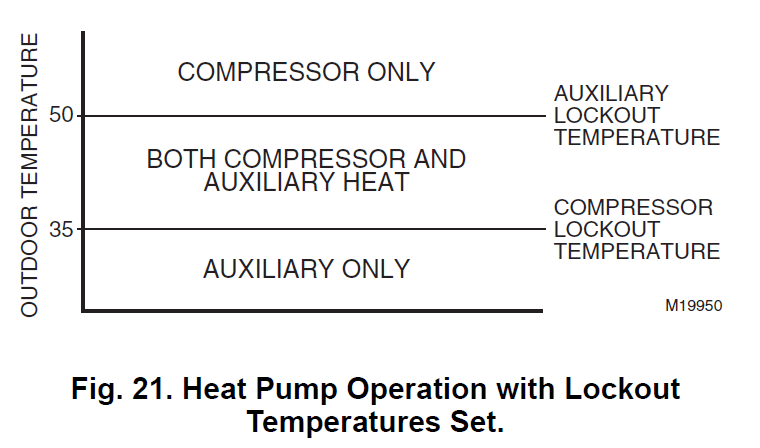
When the outdoor temperature is between the two temperatures, both the Compressor and Auxiliary Heat operate.
OPERATION IN THE EMERGENCY HEAT MODE
Once the comfort control is placed into the Emergency Heat mode, the compressor and auxiliary lockout features are turned off. In the Emergency heat mode, the compressor is locked out. The first stage of heat is whatever is connected to the X2 terminal. The second stage of heat is connected to the W1 terminal. Usually the emergency and auxiliary heat sources are electric strip heat in these cases.
Dehumidification Droop Control
The dehumidification control attempts to control to the user’s humidity setpoint by turning on the air conditioner. In extremely high humidity conditions, the comfort control keeps the air conditioner running for up to 3°F below the temperature setpoint. It does this while trying to achieve the desired humidity setpoint and balancing that with the temperature setpoint.
TROUBLESHOOTING (SEE TABLE 6)
Table 6. Troubleshooting.
| Symptom | Possible Cause | Action |
| Display does not come on. | Comfort control is not being powered. | Check for 24 Vac between B and c. |
| Temperature settings do not change. | The upper or lower temperature limits were reached. | Check temperature setpoints. Check Installer Setup Numbers 0 00 and 0 10; modify as needed. |
| The keypad is fully locked. | Check Installer Setup Number 0 70 to change keypad locked options. | |
| Heating or cooling does not come on. | Comfort control minimum off- time is activated. | Wait up to five minutes for the system to respond. |
| System selection is not set to Heat or Cool. | Set system Selection to correct position. | |
| System type Selection is incorrect. | Check Installer Setup Number 0170 and make sure correct System type is chosen. | |
| Comfort control is calling for Heat (Heat on) or Cool (Cool on) but no heating or cooling is running. | Heating or cooling equipment is not operating. | Check wiring. Check Installer Setup Number 0170 and make sure correct system type is chosen. Verify operation of equipment in System Test mode. |
| Comfort control does not respond when touch areas are pressed. | The keypad is locked. | Check Installer Setup Number 0 70 to change keypad locked options. |
For more manuals by Trane, visit ManualsLibraryy
Trane TCONT803AS32DA Multi-Stage Thermostat-FAQs
What does the Auto setting do on my Trane thermostat?
The Auto setting allows the thermostat to automatically control your HVAC system to maintain the desired temperature by turning the unit on or off as needed.
How do I get my Trane thermostat to work?
If your thermostat is locked, press the “+” and “-” buttons at the same time for 3–4 seconds. If it still doesn’t work, try resetting the thermostat, changing the batteries, or cleaning any dust inside.
How do I control the temperature on my thermostat?
Adjust the temperature by using the up and down buttons or a dial. For programmable models, you may need to enter a programming mode to set schedules.
How do I change the setpoint on my Trane thermostat?
To adjust the setpoint, select the active period’s cooling or heating setpoint, then use the up or down arrows to change the temperature.
How do I adjust the fan speed on my Trane thermostat?
Tap the Fan Mode button at the bottom of the screen, then choose between “On” or “Circulate.” Next, select your preferred fan speed: High (100%), Medium (75%), or Low (50%), and press “Done.”
What is the auto on and off setting on a thermostat?
The AUTO setting cycles the system on and off to prevent moisture from collecting in the air, improving system efficiency and preventing the system from overworking.
What is auto mode on a Trane thermostat?
In AUTO mode, the fan turns on only when the system is heating or cooling, then shuts off once the desired temperature is reached.
How do I change the thermostat mode?
Turn the dial to highlight “Mode” and press to select it. Then, choose the mode (Heat or Cool) you want to set, and adjust the temperature as needed.

